Empress Irene › Empuries › The Sack of Rome by the Gauls, 390 BCE » Origins and History
Articles and Definitions › Contents
- Empress Irene › Who Was?
- Empuries › Ancient History
- The Sack of Rome by the Gauls, 390 BCE › Antique Origins
Ancient civilizations › Historical places, and their characters
Empress Irene › Who Was?
Definition and Origins
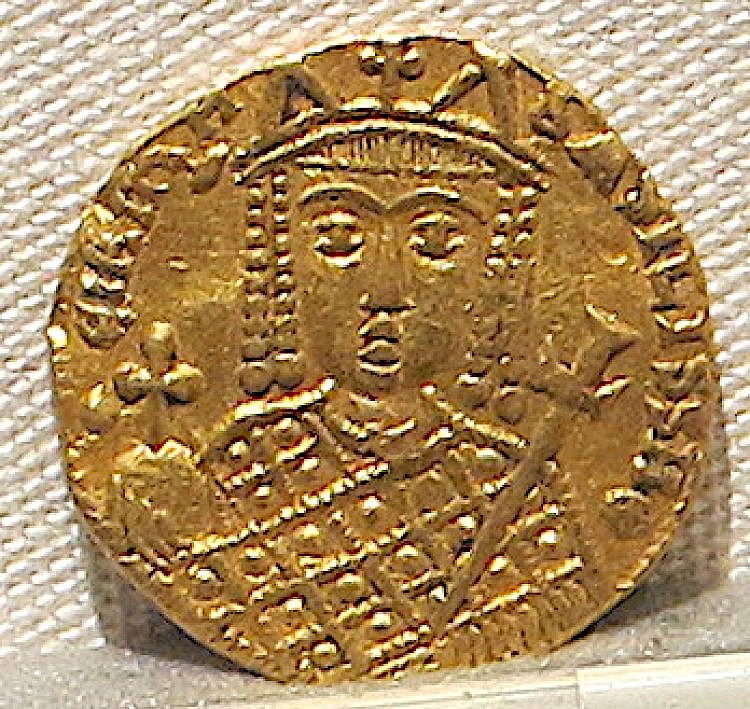
Empress Irene was the wife of Leo IV and, on her husband's death, she reigned as regent for her son Constantine VI from 780 to 790 CE. From 797 to 802 CE she ruled as emperor in her own right, the first woman to do so in Byzantine history.During her lacklustre reign, Irene ruthlessly schemed and plotted to keep the throne she would lose and regain three times, but she is chiefly remembered for restoring the Christian veneration of icons, which her predecessors of the Isaurian dynasty had sought so vehemently to repress. Even this seemingly pious campaign was really only a means for Irene to defeat her enemies and keep power. The Empress' gold coins reveal much of her duplicitous character for, uniquely, they carried a portrait of herself on both sides.
EARLY LIFE
Little is known of the young Irene except that she was an extraordinarily beautiful orphan girl from Athens, born c. 752 CE.Emperor Constantine V (r. 741-775 CE), holding an empire -wide beauty contest for the purpose, fished her from the obscurity of the provincial town that Athens had then become and arranged for her to marry his son, the future emperor Leo IV, who would reign from 775 to 780 CE. The wedding took place in 769 CE, and she immediately influenced state policy by tempering her husband's attacks on the Church's veneration of icons. Leo's short reign came to an end when he died of fever, aged 30, while campaigning against the Bulgars, but Irene's appetite for power needed further feeding.
IRENE AS REGENT
Constantine VI ruled from 780 to 797 CE, inheriting his title aged just nine. Ruling as regent for her young son over the next decade, Irene quashed a rebellion led by the sons of Constantine V, dismissed ministers and military men whose loyalty was questionable and made use of the experience of two court eunuchs, in particular, Staurakios and Aetios. The former was logothetes tou dromou or chief minister with a wide range of powers. In 783 CE Staurakios sent a Byzantine army to fight the Slavs in Greece, and the next year Irene enjoyed the first military successes of her reign against both Slav and Arab armies.
IRENE & 350 BISHOPS FINALLY RULED TO RESTORE THE ORTHODOXY OF THE VENERATION OF ICONS IN THE CHRISTIAN CHURCH.
Religious affairs seem always to have been foremost in the regent's plans, and in 784 CE she made her former secretary Tarasios the Patriarch (Bishop) of Constantinople, despite him not yet being ordained. Next, Irene convened a Church council in Constantinople in 786 CE to put an official end to the destruction of icons (iconoclasm). However, influential members of the army were against such a move, and they organised a riot which forced the closure of the council meetings.The Empress was not to be deterred, though, and she swiftly stationed the troublemakers to Asia Minor under the guise of preparations for a new military campaign. Once abroad the army was disbanded and their positions of authority back home taken by those more loyal to the Empress.
With the army opposition dealt with, Staurakios accompanied Irene to the Seventh Ecumenical Council at Nicaea in September 787 CE. There Irene and 350 invited bishops finally ruled to restore the orthodoxy of the veneration of icons in the Christian Church and end iconoclasm. The persecution of iconophiles had been a key feature of previous emperors' reigns, especially Irene's father-in-law Constantine V, so the Empress could not be too harsh on the perpetrators and risk alienating family members at court. Instead, they were permitted to repent of their sins and welcomed back into the Church now glittering once again with its precious icons.
EXILE FROM COURT
When Irene made it be known that she intended to rule above her son Constantine no matter how old he was, many of those who opposed the restoration of icons, saw the dangers to the empire's army strength Irene's purges had threatened, and who believed Constantine had the rightful claim to the throne alone, rallied around the young emperor. Irene responded by throwing him in prison, but by 790 CE the army came to Constantine's support and released him. The army still contained many iconoclasts, and they had refused to swear loyalty to Irene alone on religious grounds. Now 19 years of age and keen to remove his interfering mother once and for all from state affairs, Constantine banished her from court along with her closest advisors while he engaged Michael Lachanodrakon, the influential general and governor of the Thrakesion region of the empire. After a decade in the shadows, Constantine took his rightful place at the apex of Byzantine government.
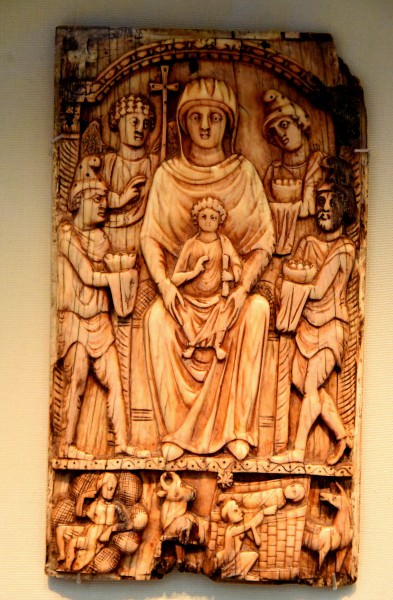
Byzantine Ivory Panel Depicting the Adoration of the Magi
Unfortunately, the young emperor was not actually up to the task. Serious and immediate defeats against the Bulgars and a shameful truce against the Arabs did nothing to aid his popularity, and conspiracies at court were rife. One led by Constantine's uncle Nikephoros was quashed, and the emperor blinded the ringleader in an all too familiar act of imperial Byzantine brutality. Constantine then ordered the tongues of all four of his uncles to be torn out. It was a rare moment of decision, but it was too little, too late.
Irene was not to be so easily ushered to the wings of power, either, and she returned to the court in 792 CE, invited by her son as a last-ditch attempt to restore some order to his reign. In effect, they ruled jointly for the next five years, but Irene soon began to plot against her son. Significantly, Constantine could no longer call on the support of Michael Lachanodrakon, the general having been killed that year while campaigning against the Bulgars. The army was all too unimpressed with the young emperor, and his popularity plummeted even further when he began to blame his soldiers for their defeats, taking the ill-advised action (cunningly suggested by Irene, of course) of tattooing the word “traitor” on the faces of 1,000 of them.
IN 797 CE IRENE TOOK BACK THE THRONE FOR HERSELF & BLINDED HER SON, DOING SO IN THE SAME PURPLE CHAMBER OF THE PALACE IN WHICH HE HAD BEEN BORN.
A final crushing blow to Constantine's ambitions was the protests following his divorce and subsequent marriage to his mistress Theodote, the so-called Moechian Controversy, in 795 CE. To make matters worse, the couple had a son 18 months later. Two monks were especially vociferous in their outrage at the emperor's behaviour as head of the Church, Plato of Sakkoudion and Theodore of Stoudios, who both claimed that his divorce was illegal and so in marrying again the emperor had committed adultery. The emperor had lost the support of the one group he could always depend on; the iconophiles.Constantine's unpopularity with his people and the Byzantine establishment meant that he had no friends left to block his removal from power by his own mother.
RETURN AS EMPRESS
In 797 CE, when Irene took back the throne for herself, she blinded her son, doing so in the same purple chamber of the palace in which he had been born. There was not going to be another rebellion against her rule. Constantine died shortly afterwards, almost certainly as a result of his injuries, which were intended to kill not maim. With his heir having already died earlier the same year, Irene now had dealt with all her challengers. Thereafter, Irene is referred to in official state records as basileus, emperor, and not as empress, the first woman to so rule in her own right.
She continued to take an interest in all matters of her empire: politics, warfare, and religion combined and tried to win favour by announcing reductions in taxes for her people. She was not without her troubles, though, as rebellion was still in the air and was given focus by the surviving, albeit maimed, sons of Constantine V. The Arabs had to be paid off to avoid further invasion, all but bankrupting the state, and the people could never quite forgive her for her crimes, even if she did provide soup kitchens for the poor and accommodation for the elderly. Riding around Constantinople in a golden chariot launching coins into the crowds did not help much either. Troubled times were in store for Byzantium ’s most ambitious and ruthless of sovereigns.
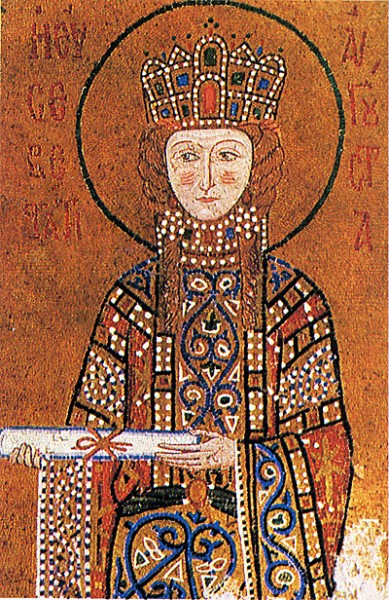
Byzantine Empress Irene
In early 802 CE, Irene attempted a marriage of alliance with the Franks ' king Charlemagne, who was also the newly declared Emperor of the Romans in the west, and who, likewise, was in favour of once more unifying the two halves of the old Roman empire. A similar plan had already been attempted when Irene had arranged for her late son to marry Rotrud, the daughter of Charlemagne, but Irene had broken off the engagement in 787 CE. However, the new approach to join the two families met fierce opposition, especially from the powerful eunuch Aetios in Constantinople. It simply would not do for a Byzantine emperor to marry an illiterate barbarian, even if he had been blessed by the Pope and wore spectacular red tights.
In October 802 CE the highest court officials in Constantinople convened in the Hippodrome and declared the Empress surplus to requirements. Irene was removed, exiled to a monastery on Lesbos and succeeded by Nikephoros I, one of the Empress' former finance ministers. Irene died within a year of losing the throne she had loved so much and clung onto for so long. The historian JJ Norwich gives this grim assessment of Irene's reign:
Scheming and duplicitous, consumed by ambition and ever thirsty for power, she brought dissension and disaster to the Empire, being additionally guilty of one of the foulest murders that even Byzantine history records.(115)
Nikephoros would reign until his death in battle in 811 CE, unable to halt the decline of the Byzantine empire as Charlemagne's own empire rose in the west and the Muslim Abbasids threatened from the east. The cycle of royal assassinations that Irene began with the murder of her son would keep on turning so that the Byzantines would see six emperors in the space of 15 years.
Empuries › Ancient History
Definition and Origins
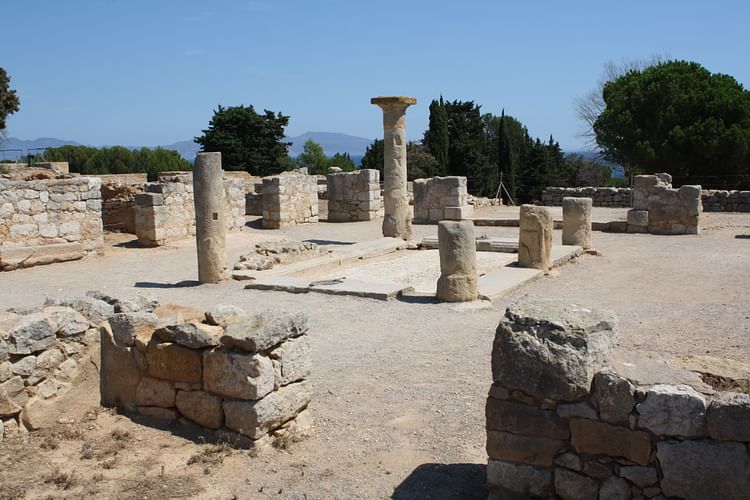
Empuries (also Emporiae or Emporion) was a Greek and then Roman colony on the northeastern coast of Spain. Thriving as a local and Mediterranean trading centre, it prospered from the 6th century BCE to the 2nd century CE. Several times the Romans used the port as a landing place for armies to invade and plunder Iberia and they established a military camp at the site which evolved into a small town embellished with the usual collection of Roman architectural features. The site today offers the visitor extensive ruins, notably a large portion of the city walls, a crytpoportico, forum space, and large private houses.
HISTORICAL OVERVIEW
Empuries was established by settlers from Massalia (Marseilles) in the 6th century BCE who founded the port of Palaeopolis on an island at the mouth of the Fluvia River. The settlers prospered through trade and then spread to the Greek town known as Neapolis near the coast which covers about 4 hectares. The two areas were called Emporion, indicative of their dependence on trade, where wine, pottery, and olive oil, along with goods from Massalia and those of Etruscan origin, were exchanged for metals and foodstuffs from the local tribes reached via the River Fluvia and the nearby River Ter.
FROM 100 BCE, THE ROMANS, EAGER TO EXPLOIT IBERIA, BUILT A NEW TOWN OVER THEIR ORIGINAL ARMY CAMP.
The Romans used the port during the Second Punic War against Carthage, with Scipio Africanus landing expeditions there in 218 and 211 BCE, and again in 195 BCE when Marcus Porcius Cato led a force to quash the Iberian revolt which sprang up in reaction to Rome ’s demands for tribute. From 100 BCE, in order to create a more permanent base from which to exploit Iberia and protect the trade route from Italy, they built a Roman town from the original army camp. Located on the coast opposite from the Greek town, which had by then covered all of the island, the Roman town was laid out in right-angled blocks and eventually spread to cover some 22.5 hectares. The town received another boost when Julius Caesar settled veterans from his legions there in 45 BCE.
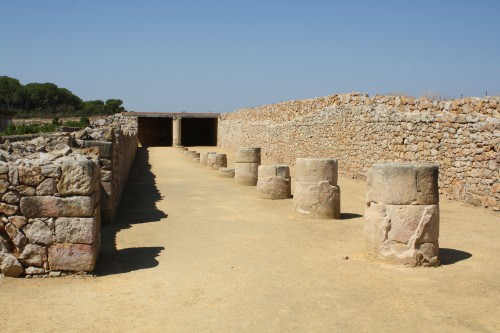
Cryptoportico, Empuries
In the reign of Augustus (27 BCE – 14 CE) the two still separate towns and a nearby indigenous Iberian settlement (Indika) were combined and awarded the status of municipium, which was given the collective name Emporiae. The town had its own forum, agora, small amphitheatre, gymnasium, and walls, and continued to mint its own coinage (which began in the 5th century BCE) with a characteristic Pegasus design. There were also temples to the Greek god of medicine Asclepius and to Serapis, the Hellenistic -Egyptian god. Empuries declined in importance for unknown reasons from the 2nd century CE but continued as a more modest, walled settlement well into the early Christian period.
ARCHITECTURAL HIGHLIGHTS
The site of the indigenous settlement Indika has yet to be located, but pottery finds suggest the area was first inhabited from the 9th century BCE, and large grain silos are evidence of the trade which went on with their Greek and Roman neighbours.The majority of the architectural remains in the Greek quarter of Empuries (the Neapolis area) belong to the Hellenistic Period and date to the 2nd and 1st centuries BCE, although some of the lower courses of the 4th century BCE fortification wall survive. The majority of the Roman town remains unexcavated and the structures which can be seen today date from the 1st century BCE to the 1st century CE.

Ground Water Filter, Empuries
Neapolis
Here are the remains of various temples and sanctuaries, notably that dedicated to Asclepius, the Greek god of medicine and healing. This dates to the 4th-2nd century BCE and its large calcareous stone podium is still visible today. Here too is an unusual ceramic water filter set into the ground and a large cistern, both dating to the Hellenistic period when the sanctuary was remodelled. The foundations of the agora (50 x 40 metres) and stoa (50 x 14 metres), originally with a 12- columnfaçade, are still visible, as are a single large public cistern and three smaller ones, to give an impression of these places where the people of Empuries met and shopped. There are also the foundations and two short staircases of the 1st-century BCE temple dedicated to Isis and Zeus Serapis. There are remains of modest one and two-roomed houses, probably used by traders and the small workshops ( tabernae ) of craftsmen. A few other homes are larger residences with colonnaded courtyards which include water-collecting drains and one residence with a hall for symposia, as indicated by the Greek ΗΔΘΚΟΙΤΟΣ ('how sweet to be reclined') laid out on the mosaic flooring. Finally, by the agora are the remains of the 4th-century CE early Christian church and cemetery with several stone sarcophagi left in situ. The cemetery was in use up to the 9th century CE and held over 500 tombs of all social classes.
Roman Forum
The Republic-era forum space had a temple (most probably dedicated to Jupiter, Juno, and Minerva ) with a front portico of four columns. The open area, paved with sandstone slabs, was enclosed on three sides by a double-colonnaded building with a cryptoportico beneath it. A portion of the latter structure has had its roof reconstructed to give an idea of how it originally looked. The forum was revamped in the Augustan period, and the main temple became enclosed behind a low wall to restrict the sacred area. At least one new temple was dedicated to the imperial cult, and a basilica was built for the city's administrators.

Mosaic Flooring, Empuries
Roman Domus
Portions of the columned atrium of the late-Republic house (domus) no. 1 survive, including a drain to collect water into the two cisterns below. The house is typical of large Roman private houses but is built on two terraces to compensate for the uneven terrain. The many rooms, courtyards, and garden areas include a small three-roomed thermal complex or balneum.The domus also has a number of impressive and well-preserved black and white mosaic floors.
Roman City Gates & Wall
A significant stretch of the Roman city walls survives on the south side. Built from the 1st century BCE and probably initially part of the Roman fortified camp, the walls were constructed using several courses of large polygonal blocks and an upper section of concrete ( opus caementicium ). Also surviving are two city gates with the portion of stone roadway beneath one showing the wear of wheeled traffic. To the sides of these gates is a phallus carved into one of the stone blocks as a protective symbol.
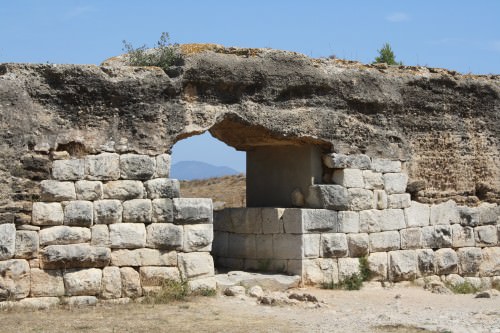
City Gate, Empuries
ARCHAEOLOGICAL FINDS
With three settlements and many more cemeteries, Empuries has a rich offering in art and everyday objects. The most impressive archaeological discovery was undoubtedly a larger-than-life statue of Asclepius. The figure, once abandoned in a cistern, combines both Pentelic and Parian marble and dates to the 4th century BCE. The statue once stood in a small sanctuary dedicated to the god. Other interesting finds, also on display in the site museum include a 5th-century BCE commercial letter written in Greek on a sheet of lead, local Iberian pottery with geometric decoration, Etruscan black glaze pottery, an Iberian sandstone stele (6th century BCE) carved with a spiral to represent a bent spear, and an altar from the peristyle of a Roman villa decorated with painted scenes. Finally, several fine emblemata mosaics survive from the large villas at the site including a detailed depiction of the sacrifice of Iphigenia from Greek mythology.
The Sack of Rome by the Gauls, 390 BCE › Antique Origins
Ancient Civilizations
After the Gauls defeated the Romans at the confluence of the Tiber and the Allia rivers, the Gauls marched on to Rome. In late July 390 BCE, the undefended city fell to the invaders to be burnt and sacked. Only on the Capitol Hill, did a small number of Romans put up a valiant defense, holding out until famine forced them to surrender. The Romans were forced to pay the Gauls a hefty ransom of gold to depart. The Gauls too had been decimated, by starvation and by malaria. To prevent their city from being sacked again, the Romans improved their military and strengthened the city wall.
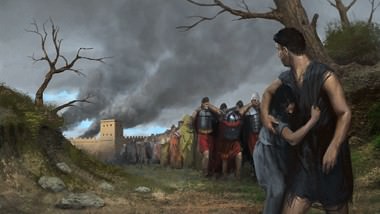
Fleeing Romans
PROLOGUE
In 391 BCE, Roman intervention broke the Gallic siege of the Etruscan city of Clusium. The next year, led by the Senones tribe and their chief Brennus, the infuriated Gauls went to war against Rome. The Roman army intercepted the Gauls on the banks of the Tiber, near its confluence with the Allia River, eleven miles (18 km) north of Rome. The Gallic charge shattered the Romans, who were utterly defeated. Now nothing seemed to stand in the way of the barbarians and the city of Rome.
ROME SACKED AND BURNT
The day after the battle, as the sun set on July 19th, the Gallic army arrived at the walls of Rome. The gates were not shut and no troops manned the walls. The ease of their victory at the Allia and the undefended city, made the Gauls suspect a trap.For now, the Gallic army encamped between Rome and the nearby River Anio. Scouts rode off to reconnoiter the walls.

Brennus
Inside Rome, the crying for the fallen was replaced by a silent terror. At night, the yelling enemy cavalry was heard outside the city walls, but no attack came. Most Romans considered their city doomed; the few remaining fighting men could never hold the walls, which were little more than an agger (earth rampart) protected by a ditch. The only hope was that the Citadel on the steep Capitol Hill could be defended. There the Senate and the men of military age, along with their families, sought refuge.The priests fled the city carrying their religious relics, alongside many of the plebs who cleared surrounding fields of anything edible.
Two days or so later, the Gauls entered the city unopposed. They were surprised that large numbers of people had already slipped through their fingers. Stationing a cordon of troops around the Capitol Hill, the Gallic army ransacked the city. The Gauls burnt and killed until the city was reduced to ruins and ashes. They then turned to finish off the defenders on the Capitol.
THE DEFENSE OF THE CITADEL
The Romans on the Capitol Hill were determined to put up a spirited defense. The Gauls advanced up the hill with shields above their heads to ward off missile fire. The Romans let them come half way up, to where it was steepest, then charged, completely overwhelming their foes.
Deciding to avoid any more fruitless casualties, the Gauls decided to starve the defenders into submission. The Gauls faced food shortage as well; the fire had consumed the city grain supplies and the surrounding fields were stripped bare. To find food, parties of Gauls set off to loot the countryside.
THE GAULS GAINED THE SUMMIT, ELUDED THE ROMAN GUARDS & DID NOT EVEN WAKE THE DOGS. HOWEVER, AT THE TEMPLE OF JUNO, THE HONKING OF HER SACRED GEESE FINALLY ALERTED THE GUARDS.
While the siege of the Capitol continued at Rome, at the city of Ardea, the Roman general Marcus Furius Camillus rallied the citizens against Gallic raiding parties. Not far from Ardea, Camillus surprised and slaughtered a large throng of Gauls.Augmented with volunteers from Latium, a new Roman army was forming at Ardea. Their leader was Camillus, who by secret messenger from the Senate was made Dictator by order of the people.
Back in Rome, according to tradition, the Gauls attempted to infiltrate the Capitol by climbing the hill near the Temple of Carmentis, a goddess of birth. The Gauls gained the summit, eluded the Roman guards and did not even wake the dogs. They could not sneak by the temple of Juno, however, as the honking of her sacred geese finally alerted the guards. Led by Marcus Manilus, the guards confronted the Gauls. Manilus faced two of the enemy, hewing through the wrist of one of them. Manilus smashed his shield into the face of the other Gaul, who toppled over the wall and down the cliff. The remainder of the Gauls on the parapet was likewise dealt with, while those still climbing were dislodged with javelins and stones.
A PHYRIC VICTORY FOR THE GAULS
After seven months of blockade both the defenders of the Capitol and the Gauls were reduced to famine. The Gauls also suffered from malaria which killed them in such numbers that they gathered their dead into piles and burnt them. Nevertheless, the Romans on the Capitol finally surrendered and agreed to pay 1000 pounds of gold for the peaceful withdrawal of the Gauls. When the gold was weighed, the Gauls produced heavier, false counter-weights. The Romans complained, whereupon Chief Brennus replied “woe to the vanquished” and threw his own sword on the scales ( Livy, The History of Rome, 5. 48).

Brennus Throws His Swords on the Scale
The sources differ on what happened next. Livy wrote that Camillus and his army appeared and ordered the Gauls to leave the gold and the city. The Gauls refused to do so, and a chaotic battle amidst the ruins ensued. The malnourished and diseased Gauls were easily routed. At the eight-mile stone on the road to Gabii, the Gauls rallied but were again defeated by Camillus.Plutarch ’s account is similar, except that few Gauls died in the city, and their main defeat was on the road to Gabii. Polybiusdoes not recount any Roman victory, stating that Gauls departed because their homelands were faced by an invasion of the Veneti. Diodorus relates that the Gauls left of their free will but were defeated by Camillus at the town of Veascium and by the Caeretans in Sabine territory.
Modern historians, for the most part, consider the defeat of the Gauls to be revisionism by classical historians loath to admit Rome's defeat. Possibly on their way home, the malnourished and diseased Gauls spread into smaller bands to ease living off the land. Such smaller bands could easily have been ambushed, allowing the Romans or allied tribes to recover at least part of the ransom.
AFTERMATH
Their defeat by the Gauls at the Allia River and the sack of their city made it clear to the Romans that they needed a more formidable army and better city defenses. The subsequent replacement of the clumsy phalanx with the smaller, more flexible maniples and the reliance on heavy infantry, armed with large semi-cylindrical rectangular shields, short swords, and javelins became defining features of the Roman army. Rome's fortifications became more formidable as well. The agger was raised and backed by five miles (8 km) of 12-foot (3.5 m) thick and 24-foot (7 m) high solid stone walls, surrounding the whole city.Although the political fallout from the defeat weakened Rome's position in Italy, the city endured and flourished. Not until eight centuries later, in 410 CE, would Rome again fall to an invader, the Germanic Visigoths.
LICENSE:
Article based on information obtained from these sources:with permission from the Website Ancient History Encyclopedia
Content is available under License Creative Commons: Attribution-NonCommercial-ShareAlike 3.0 Unported. CC-BY-NC-SA License